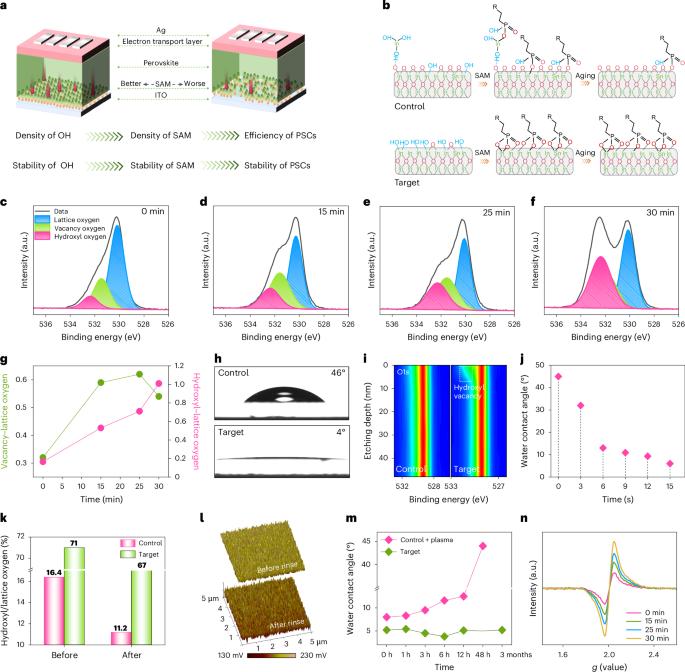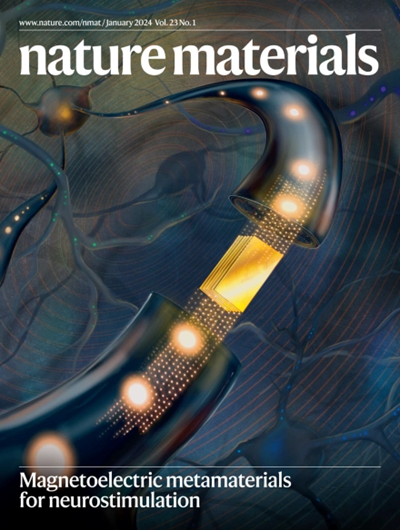Engineering bonding sites enables uniform and robust self-assembled monolayer for stable perovskite solar cells
IF 38.5
1区 材料科学
Q1 CHEMISTRY, PHYSICAL
引用次数: 0
Abstract
The efficiency of perovskite solar cells has recently been dramatically improved by a self-assembled monolayer (SAM), but forming uniform, dense and especially stable SAM remains a challenge. The hydroxyl groups on indium tin oxide (ITO) serve as the bonding sites for the SAM molecule, directly determining the distribution and anchoring stability of SAM. We developed a solution-based strategy to fully hydroxylate the ITO in as fast as 15 s. Moreover, further hydroxylation etching could also create abundant uncoordinated indium ions on the new exposed ITO surface for the anchoring of SAM by forming coordination bonds. In addition, the rapid hydroxylation etching allows commercial ITO to be directly used to omit the conventional multistep ITO pretreatment. Moreover, hydroxylation etching can also spontaneously form nano-antireflective structures on ITO to improve photon transmission. The versatile bonding site engineering resulted in better SAM anchoring, which delivered efficient perovskite solar cells (power conversion efficiency, 26.6%) that only lose 4% of the initial efficiency after 2,800 h of operation at 65 °C (ISOS-L-2 protocol). Formation of a stable self-assembled monolayer for high-efficiency perovskite solar cells remains a challenge. Here uniform and stable SAM anchoring is achieved on a hydroxylated indium tin oxide surface, leading to highly efficient and stable perovskite solar cells.


工程键合点为稳定的钙钛矿太阳能电池提供了均匀而坚固的自组装单层
钙钛矿太阳能电池的效率最近因自组装单层(SAM)而显著提高,但形成均匀、致密和特别稳定的SAM仍然是一个挑战。氧化铟锡(ITO)上的羟基作为SAM分子的键合位点,直接决定了SAM的分布和锚定稳定性。我们开发了一种基于溶液的策略,可以在15秒内完全羟基化ITO。此外,进一步的羟基化蚀刻还可以在新暴露的ITO表面产生丰富的非配位铟离子,通过形成配位键来锚定SAM。此外,快速羟基化蚀刻允许商业ITO直接使用,以省略传统的多步骤ITO预处理。此外,羟基化蚀刻还可以自发地在ITO上形成纳米抗反射结构,以提高光子的透射率。多功能键合位点工程导致更好的SAM锚定,从而提供高效的钙钛矿太阳能电池(能量转换效率为26.6%),在65°C (iso - l -2协议)下运行2,800小时后仅损失4%的初始效率。
本文章由计算机程序翻译,如有差异,请以英文原文为准。
求助全文
约1分钟内获得全文
求助全文
来源期刊

Nature Materials
工程技术-材料科学:综合
CiteScore
62.20
自引率
0.70%
发文量
221
审稿时长
3.2 months
期刊介绍:
Nature Materials is a monthly multi-disciplinary journal aimed at bringing together cutting-edge research across the entire spectrum of materials science and engineering. It covers all applied and fundamental aspects of the synthesis/processing, structure/composition, properties, and performance of materials. The journal recognizes that materials research has an increasing impact on classical disciplines such as physics, chemistry, and biology.
Additionally, Nature Materials provides a forum for the development of a common identity among materials scientists and encourages interdisciplinary collaboration. It takes an integrated and balanced approach to all areas of materials research, fostering the exchange of ideas between scientists involved in different disciplines.
Nature Materials is an invaluable resource for scientists in academia and industry who are active in discovering and developing materials and materials-related concepts. It offers engaging and informative papers of exceptional significance and quality, with the aim of influencing the development of society in the future.
 求助内容:
求助内容: 应助结果提醒方式:
应助结果提醒方式:


